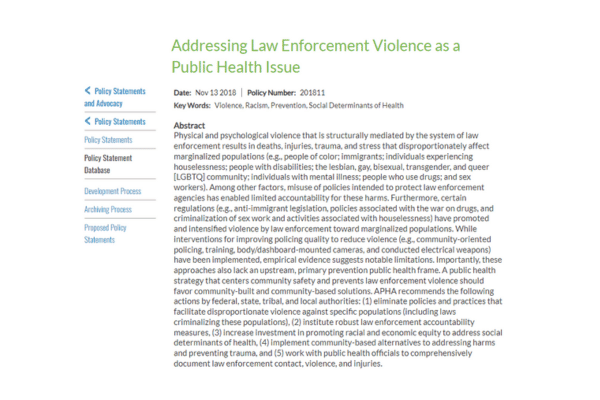Project Info
Project Description
Physical and psychological violence that is structurally mediated by the system of law enforcement results in deaths, injuries, trauma, and stress that disproportionately affect marginalized populations (e.g., people of color; immigrants; individuals experiencing houselessness; people with disabilities; the lesbian, gay, bisexual, transgender, and queer [LGBTQ] community; individuals with mental illness; people who use drugs; and sex workers). Among other factors, misuse of policies intended to protect law enforcement agencies has enabled limited accountability for these harms. Furthermore, certain regulations (e.g., anti-immigrant legislation, policies associated with the war on drugs, and criminalization of sex work and activities associated with houselessness) have promoted and intensified violence by law enforcement toward marginalized populations. While interventions for improving policing quality to reduce violence (e.g., community-oriented policing, training, body/dashboard-mounted cameras, and conducted electrical weapons) have been implemented, empirical evidence suggests notable limitations. Importantly, these approaches also lack an upstream, primary prevention public health frame. A public health strategy that centers community safety and prevents law enforcement violence should favor community-built and community-based solutions. APHA recommends the following actions by federal, state, tribal, and local authorities: (1) eliminate policies and practices that facilitate disproportionate violence against specific populations (including laws criminalizing these populations), (2) institute robust law enforcement accountability measures, (3) increase investment in promoting racial and economic equity to address social determinants of health, (4) implement community-based alternatives to addressing harms and preventing trauma, and (5) work with public health officials to comprehensively document law enforcement contact, violence, and injuries.
Organization: American Public Health Association
Resource Type:Peer-Reviewed Journal Article

